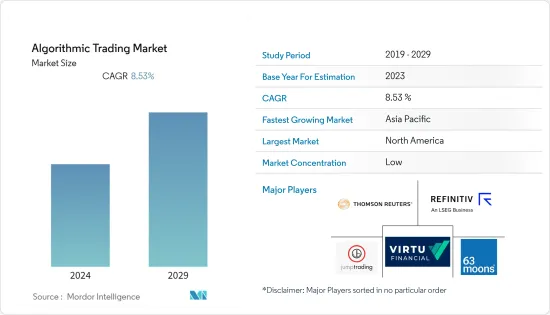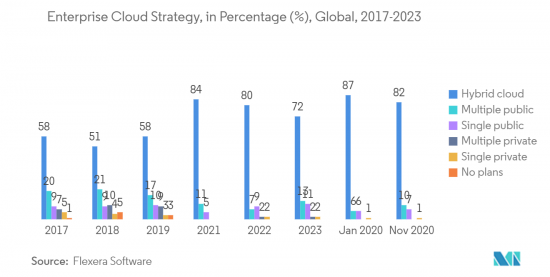 |
市場調査レポート
商品コード
1404537
アルゴリズム取引:市場シェア分析、産業動向・統計、成長予測、2024年~2029年Algorithmic Trading - Market Share Analysis, Industry Trends & Statistics, Growth Forecasts 2024 - 2029 |
||||||
● お客様のご希望に応じて、既存データの加工や未掲載情報(例:国別セグメント)の追加などの対応が可能です。 詳細はお問い合わせください。
| アルゴリズム取引:市場シェア分析、産業動向・統計、成長予測、2024年~2029年 |
|
出版日: 2024年01月04日
発行: Mordor Intelligence
ページ情報: 英文 100 Pages
納期: 2~3営業日
|
- 全表示
- 概要
- 目次
アルゴリズム取引市場の今年度の市場規模は144億2,000万米ドルで、CAGRは8.53%を記録し、5年後には237億4,000万米ドルに達すると予想されています。
トレーダーは従来から、取引業務や投資ポートフォリオを把握するために市場監視技術を利用してきました。アルゴリズム取引のようなインテリジェンスを内蔵したアプリケーションは、ユーザーが指定した利回りやその他のパラメーターに基づいて、さまざまな機会を求めて市場を探索することができます。

主なハイライト
- アルゴリズム取引業界のニーズは、有利な政府規制、迅速で信頼性が高く効率的な注文執行に対する需要の高まり、市場監視に対する需要の増加、取引コストの低下によって高まると予想されます。大手証券会社や機関投資家は、大量取引にかかる費用を削減するためにアルゴリズム取引を利用しています。さらに、人工知能(AI)と金融サービスアルゴリズムの開発により、魅力的な市場拡大機会が生まれると予想されます。クラウドベースのソリューションに対する需要の高まりも、アルゴリズム取引市場の成長を後押しすると予想されます。
- 技術革命は、世界との関わり方やビジネスのあり方を大きく変えました。しかし、成熟期を迎えたとは言い難く、産業全体を破壊し、著しく新しいビジネスモデルを生み出す可能性のある、さらに破壊的な技術やアプローチが明らかになりつつあります。高度でインテリジェントな取引システムは、近年の市場や技術の進歩とともに進化してきました。これらのシステムは、さまざまなレベルの自動取引を可能にするため、近年ますます普及しています。
- 最新の取引所にマッチングエンジンが導入されて以来、アルゴリズム取引は世界的に利用されています。人為的な制約を取り払うことで、このような技術的進歩は市場の注文・取引処理能力を向上させました。その結果、調査された市場の時間軸は秒単位からミリ秒単位へと変化し、市場の監視はトレーディングピットからコンピュータへと移行しました。政府によるものであれ取引所によるものであれ、市場監視は市場の健全性を守り、非倫理的な行為から市場参入企業を守るものです。
- アルゴリズム取引には利点がある一方で、暴落(いわゆる「フラッシュ・クラッシュ」)や流動性の即時喪失を引き起こすことで、調査された市場のネガティブな動向を増幅させる可能性もあります。流動性の即時喪失は、市場の成長を抑制する可能性があります。
- COVID-19の大流行は、世界のロックダウンのため、テクノロジーへの依存を高めることになった。ボラティリティの高い市場環境、取引量の多さ、リモートワーク環境に対応するための迅速なデジタルトランスフォーメーションの推進などが、アルゴリズム取引の増加につながっています。
アルゴリズム取引の市場動向
オンクラウドの展開セグメントが市場成長を牽引する見込み
- クラウド技術は、プロセスを自動化し、データを効率的に保存・管理する方法を提供します。また、クラウドベースの取引では、リモートサーバーで取引を処理できる利点があります。これにより、現場のITインフラコストが削減され、取引のテストやモデル化におけるクラウドの能力が強化されます。
- クラウド展開の時代において、クラウドベースのアルゴリズム取引プラットフォームは、市場の成長において重要な役割を果たすと予測されます。クラウドベースの取引ソリューションにより、トレーダーは取引プロセスを自動化できるため、最大限の利益を得ることができ、取引データのメンテナンスが容易で、拡張性があり、費用対効果が高く、効果的な管理が可能であるなど、さまざまな利点があるためです。
- クラウドベースのトレーディングはクラウドコンピューティングモデルで動作し、一般的にインターネット経由でアクセスできるリモートサーバーのネットワークを使用してデータを管理、保存、処理します。クラウドの利便性により、トレーダーはクラウド上でアルゴリズム取引を展開し、取引を実行しながら新しい取引戦略の確認、バックテスト、時系列分析を行うことができます。
- 主要な株式市場では、取引戦略を実行するアプリケーションやボットを使って、ほとんどの株式取引が自動化されていることはよく知られています。最近、金融サービス業界の新たな動向として、アルゴリズム取引ソリューションのような取引ソリューションのクラウド化が進んでいます。ここ数年、クラウドをベースとしたアルゴリズム取引ソリューションを利用するトレーダーが増えています。
- クラウドの大きなメリットの1つは、ビジネスの俊敏性です。クラウドサービスプロバイダーが提供するテクノロジーや継続的なイノベーションに簡単かつ迅速にアクセスできる能力を活用し、さらに、トレーダーが高額な先行投資をすることなく、新しいテクノロジーやソリューションを実験的、試験的に利用できる従量課金モデルを採用しています。具体的には、資本市場企業がオンプレミスのソリューションをクラウドに拡張したり、クラウドネイティブなソリューションを構築したりする場合、さまざまな使用事例やメリットがあります。フレクセラ・ソフトウェアによると、2023年現在、企業の回答者の72%がハイブリッドクラウドを導入していると回答しています。

北米が大きな市場シェアを占める見込み
- 今回調査した市場において、北米が最も大きなシェアを占めると予想されます。予測期間を通じて市場成長を促進する主な要因は、取引技術(ブロックチェーンなど)への投資の増加、アルゴリズム取引サプライヤーの存在感の高まり、同地域における国際取引に対する政府の後押しの拡大です。
- 高頻度取引(HFT)を含むアルゴリズム取引戦略が米国証券市場で普及するにつれ、これらの戦略が市場や企業の安定性に悪影響を与える可能性も同様に高まっています。
- 現代のテクノロジーは、関連するすべての取引手順を自動化することで、従来の投資モデルの形式を急速に変化させ、すべての潜在的投資家がアクセスできる安全で効果的なエコシステムの開発を可能にしています。
- 北米のアルゴリズム取引市場は、米国証券取引委員会(SEC)や金融業規制機構(FINRA)といった機関が管理する規制の枠組みの中で運営されています。これらの規制機関は、市場の健全性、公正な慣行、リスク管理を確保するためのルールやガイドラインを導入しています。
- アルゴリズム取引は、資産運用会社、ヘッジファンド、年金基金などの機関投資家の間で大きな支持を得ています。これらの機関投資家は、効率性の向上、執行の最適化、リスク管理のためにアルゴリズム取引戦略を採用しています。高度なトレーディングプラットフォームと市場データへのアクセスが可能になったことで、アルゴリズム取引の普及が促進されました。
アルゴリズム取引業界の概要
アルゴリズム取引市場は、トムソン・ロイター、Jump Trading LLC、Refinitiv Ltd、63 Moons Technologies Limited、Virtu Financial Inc.などの大手企業が存在し、非常に細分化されています。同市場のプレーヤーは、製品ラインナップを強化し、持続可能な競争優位性を獲得するために、提携や買収などの戦略を採用しています。
その他の特典
- エクセル形式の市場予測(ME)シート
- 3ヶ月間のアナリスト・サポート
目次
第1章 イントロダクション
- 調査の前提条件と市場定義
- 調査範囲
第2章 調査手法
第3章 エグゼクティブサマリー
第4章 市場洞察
- 市場概要
- 業界の魅力度-ポーターのファイブフォース分析
- 供給企業の交渉力
- 買い手/消費者の交渉力
- 新規参入業者の脅威
- 代替品の脅威
- 競争企業間の敵対関係の強さ
- COVID-19の市場への影響
- 技術スナップショット
- アルゴリズム取引戦略
- モメンタム取引
- 裁定取引
- 動向フォロー
- 執行ベースの戦略
- センチメント分析
- インデックスファンドのリバランス
- 数理モデルに基づく戦略
- その他のアルゴリズム取引戦略
- アルゴリズム取引戦略
第5章 市場力学
- 市場促進要因
- 高速で信頼性が高く、効果的な注文執行に対する需要の高まり
- 取引コストの削減による市場監視への需要の高まり
- 市場抑制要因
- 流動性の即時喪失
第6章 市場セグメンテーション
- トレーダータイプ別
- 機関投資家
- 個人投資家
- 長期トレーダー
- 短期トレーダー
- コンポーネント別
- ソリューション
- プラットフォーム
- ソフトウェアツール
- サービス
- ソリューション
- 展開別
- オンクラウド
- オンプレミス
- 組織規模別
- 中小企業
- 大企業
- 地域別
- 北米
- 欧州
- アジア太平洋
- ラテンアメリカ
- 中東・アフリカ
第7章 競合情勢
- 企業プロファイル
- Thomson Reuters
- Jump Trading LLC
- Refinitiv Ltd
- 63 Moons Technologies Limited
- Virtu Financial Inc.
- MetaQuotes Software Corp.
- Symphony Fintech Solutions Pvt. Ltd
- Info Reach Inc.
- ARGO SE
- IG Group
- Kuberre Systems Inc.
- Algo Trader AG
第8章 投資分析
第9章 市場機会と今後の動向

The Algorithmic Trading Market was valued at USD 14.42 billion in the current year and is expected to register a CAGR of 8.53%, reaching USD 23.74 billion in five years. Traders have traditionally used market surveillance technology to keep track of their trading operations and investment portfolios. Applications with built-in intelligence, like algorithmic trading, can explore the market for various opportunities based on the yield and other parameters the user specifies.
Key Highlights
- The need for the algorithmic trading industry is anticipated to be driven by favorable governmental rules, rising demand for quick, reliable, and efficient order execution, increasing demand for market surveillance, and declining transaction costs. Large brokerage firms and institutional investors use algorithmic trading to reduce the expenses of bulk trading. Additionally, it is anticipated that the development of artificial intelligence (AI) and financial service algorithms will create attractive market expansion opportunities. A rise in the demand for cloud-based solutions is also anticipated to support the growth of the algorithmic trading market.
- The technological revolution has altered how one can interact with the world and do business. But, far from reaching maturity, the revolution continues to unfold, revealing even more disruptive technologies and approaches capable of disrupting entire industries and spawning significantly new business models. Advanced and intelligent trading systems have evolved with markets and technological advances in recent years. These systems have become increasingly popular in recent years as they enable different levels of automated trading.
- Since the introduction of matching engines in modern exchanges, algorithmic trading has been used globally. By removing human restrictions, such technological advancements have enhanced the capacity of markets to process orders and trades. As a result, the studied market's timeline shifted from seconds to milliseconds, and market surveillance was transferred from the trading pit to computers. Whether conducted by a government or an exchange, market surveillance safeguards market integrity and protects participants from unethical behavior.
- While algorithmic trading has its advantages, it can also amplify the negative trends in the market studied by causing crashes (so-called "flash crashes") and immediate loss of liquidity. The instant loss of liquidity can restrain market growth.
- The COVID-19 pandemic led to increased dependence on technologies owing to the global lockdowns. The volatile market conditions, high trading volume, and drive for rapid digital transformation to cope with the remote working environment have all contributed to the uptick in algorithmic trading.
Algorithmic Trading Market Trends
On-cloud Deployment Segment is expected to drive the Market Growth
- Cloud technologies provide ways to automate processes and efficiently store and maintain data. In addition, cloud-based trading offers the benefits of remote servers to process trades. This reduces onsite IT infrastructure costs and augments the cloud's power to test and model trades.
- In the age of cloud deployment, cloud-based algorithmic trading platforms are projected to play a crucial role in the growth of the market, owing to various benefits, such as obtaining maximum profits, as cloud-based trading solutions enable traders to automate their trading process, easy trade data maintenance, scalability, cost-effectiveness, and effective management.
- Cloud-based trading works on the cloud computing model, which uses networks of remote servers generally accessed over the internet to manage, store, and process data. Attributed to the convenience of the cloud, traders can deploy algorithmic trading in the cloud to check new trading strategies, backtest, and run-time series analysis while executing trades.
- It is well known that most stock transactions are automated in significant stock markets using applications or bots implementing a trading strategy. Recently, an emerging trend in the financial services industry has been the movement of trading solutions, like algorithmic trading solutions, to the cloud. More and more traders have been using algorithmic trading solutions based on the cloud for the past few years.
- One of the significant benefits of the cloud is business agility, leveraging the ability to easily and quickly access technology and continuous innovation provided by cloud service providers, along with a pay-as-you-go model, which enables a trader to experiment and pilot new technologies and solutions without high upfront investments. More specifically, there are various use cases and benefits for capital markets firms extending their on-premises solutions to the cloud or building cloud-native solutions. According to Flexera Software, As of 2023, 72 percent of the enterprise respondents indicated that they had deployed a hybrid cloud in their organization.

North America is Expected to Hold Significant Market Share
- North America is expected to have the most significant market share in the market studied. The main drivers of market growth throughout the forecast period are the rising investments in trading technologies (such as blockchain), the growing presence of algorithmic trading suppliers, and the expanding government backing for international trading in the region.
- As algorithmic trading strategies, including high-frequency trading (HFT), have grown more widespread in the US securities markets, the potential for these strategies to adversely impact market and firm stability has likewise increased.
- Modern technology is rapidly transforming the formats of conventional investment models by automating all associated trading procedures, enabling the development of a secure and effective ecosystem that will be accessible to all potential investors.
- The algorithmic trading market in North America operates within a regulatory framework governed by agencies such as the U.S. Securities and Exchange Commission (SEC) and the Financial Industry Regulatory Authority (FINRA). These regulatory bodies have implemented rules and guidelines to ensure market integrity, fair practices, and risk management.
- Algorithmic trading has gained substantial traction among institutional investors, including asset management firms, hedge funds, and pension funds. These entities employ algorithmic trading strategies to enhance efficiency, optimize execution, and manage risk. The availability of sophisticated trading platforms and access to market data have facilitated the widespread adoption of algorithmic trading.
Algorithmic Trading Industry Overview
The algorithmic trading market is highly fragmented with the presence of major players like Thomson Reuters, Jump Trading LLC, Refinitiv Ltd, 63 Moons Technologies Limited, and Virtu Financial Inc. Players in the market are adopting strategies such as partnerships and acquisitions to enhance their product offerings and gain sustainable competitive advantage.
In June 2023, Virtu Financial launched Alert+, a new workflow solution available in POSIT Alert that enhances the features of POSIT Alert by providing automated routing to Virtu's Covert execution algorithm to seek non-displayed liquidity.
In October 2022, Multi Commodity Exchange of India Limited (MCX) partnered with 63 Moons Technologies for software technology services for three months to continue to experience seamless trading.
In October 2022, Refinitiv, an LSEG business, announced the introduction of a secure, personalized, and frictionless global digital onboarding solution to assist businesses in streamlining their approach to onboarding customers. Refinitiv's digital customer onboarding solution offers a fully configurable user interface, allowing organizations to provide the product application process that can be delivered via the web, mobile, and API.
Additional Benefits:
- The market estimate (ME) sheet in Excel format
- 3 months of analyst support
TABLE OF CONTENTS
1 INTRODUCTION
- 1.1 Study Assumptions and Market Definition
- 1.2 Scope of the Study
2 RESEARCH METHODOLOGY
3 EXECUTIVE SUMMARY
4 MARKET INSIGHTS
- 4.1 Market Overview
- 4.2 Industry Attractiveness - Porter's Five Forces Analysis
- 4.2.1 Bargaining Power of Suppliers
- 4.2.2 Bargaining Power of Buyers/Consumers
- 4.2.3 Threat of New Entrants
- 4.2.4 Threat of Substitute Products
- 4.2.5 Intensity of Competitive Rivalry
- 4.3 Impact of COVID-19 on the Market
- 4.4 Technology Snapshot
- 4.4.1 Algorithmic Trading Strategies
- 4.4.1.1 Momentum Trading
- 4.4.1.2 Arbitrage Trading
- 4.4.1.3 Trend Following
- 4.4.1.4 Execution-based Strategies
- 4.4.1.5 Sentiment Analysis
- 4.4.1.6 Index-fund Rebalancing
- 4.4.1.7 Mathematical Model-based Strategies
- 4.4.1.8 Other Algorithmic Trading Strategies
- 4.4.1 Algorithmic Trading Strategies
5 MARKET DYNAMICS
- 5.1 Market Drivers
- 5.1.1 Rising Demand for Fast, Reliable, and Effective Order Execution
- 5.1.2 Growing Demand for Market Surveillance Augmented by Reduced Transaction Costs
- 5.2 Market Restraints
- 5.2.1 Instant Loss of Liquidity
6 MARKET SEGMENTATION
- 6.1 By Types of Traders
- 6.1.1 Institutional Investors
- 6.1.2 Retail Investors
- 6.1.3 Long-term Traders
- 6.1.4 Short-term Traders
- 6.2 By Component
- 6.2.1 Solutions
- 6.2.1.1 Platforms
- 6.2.1.2 Software Tools
- 6.2.2 Services
- 6.2.1 Solutions
- 6.3 By Deployment
- 6.3.1 On-cloud
- 6.3.2 On-premise
- 6.4 By Organization Size
- 6.4.1 Small and Medium Enterprises
- 6.4.2 Large Enterprises
- 6.5 By Geography
- 6.5.1 North America
- 6.5.2 Europe
- 6.5.3 Asia Pacific
- 6.5.4 Latin America
- 6.5.5 Middle East and Africa
7 COMPETITIVE LANDSCAPE
- 7.1 Company Profiles
- 7.1.1 Thomson Reuters
- 7.1.2 Jump Trading LLC
- 7.1.3 Refinitiv Ltd
- 7.1.4 63 Moons Technologies Limited
- 7.1.5 Virtu Financial Inc.
- 7.1.6 MetaQuotes Software Corp.
- 7.1.7 Symphony Fintech Solutions Pvt. Ltd
- 7.1.8 Info Reach Inc.
- 7.1.9 ARGO SE
- 7.1.10 IG Group
- 7.1.11 Kuberre Systems Inc.
- 7.1.12 Algo Trader AG
